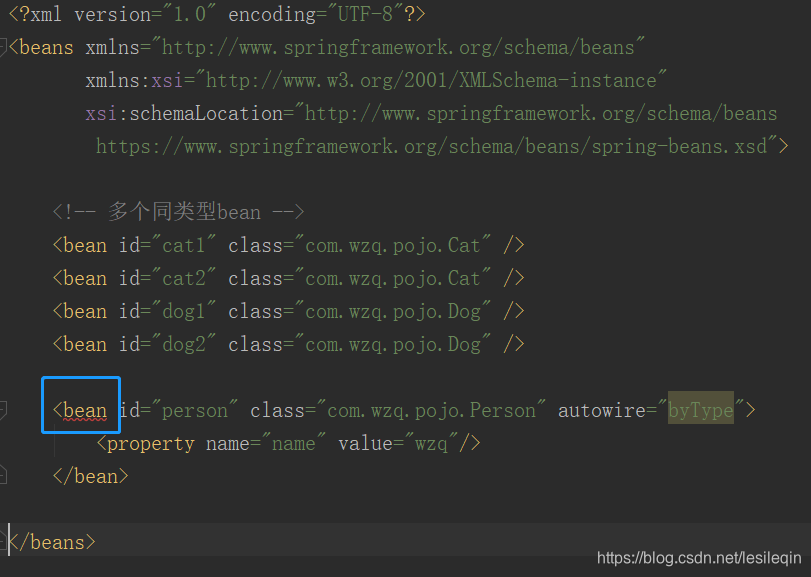一、搭建环境
环境就是:一人一猫一狗,人拥有一只猫和一只狗,狗和猫都会叫!
狗类:
package com.wzq.pojo;
public class Dog {
public void shout(){
System.out.println("汪汪汪~");
}
}
猫类:
package com.wzq.pojo;
public class Cat {
public void shout(){
System.out.println("喵喵喵~");
}
}
人的pojo类:
package com.wzq.pojo;
public class Person {
private String name;
private Dog dog;
private Cat cat;
public String getName() {
return name;
}
public void setName(String name) {
this.name = name;
}
public Dog getDog() {
return dog;
}
public void setDog(Dog dog) {
this.dog = dog;
}
public Cat getCat() {
return cat;
}
public void setCat(Cat cat) {
this.cat = cat;
}
}
beans.xml:
<?xml version="1.0" encoding="UTF-8"?>
<beans xmlns="http://www.springframework.org/schema/beans"
xmlns:xsi="http://www.w3.org/2001/XMLSchema-instance"
xsi:schemaLocation="http://www.springframework.org/schema/beans
https://www.springframework.org/schema/beans/spring-beans.xsd">
<bean id="cat" class="com.wzq.pojo.Cat" />
<bean id="dog" class="com.wzq.pojo.Dog" />
<bean id="person" class="com.wzq.pojo.Person" autowire="byName">
<property name="name" value="wzq"/>
</bean>
</beans>
测试类(先进行自动装配,然后再写这个类):
import com.wzq.pojo.Person;
import org.junit.Test;
import org.springframework.context.ApplicationContext;
import org.springframework.context.support.ClassPathXmlApplicationContext;
public class MyTest {
@Test
public void Test(){
ApplicationContext context = new ClassPathXmlApplicationContext("beans.xml");
Person person = context.getBean("person", Person.class);
person.getCat().shout();
person.getDog().shout();
}
}
二、byName
byName会自动在容器上下文中查找,和自己对象set方法后面的值相对应(首字母小写)对应的bean 的 id,语法格式很简单:
<bean id="id" class="全类型限定名" autowire="byName">
</bean>
只需要在<bean>标签,后面加个autowire="byName"即可,现在写一下完整的:
<?xml version="1.0" encoding="UTF-8"?>
<beans xmlns="http://www.springframework.org/schema/beans"
xmlns:xsi="http://www.w3.org/2001/XMLSchema-instance"
xsi:schemaLocation="http://www.springframework.org/schema/beans
https://www.springframework.org/schema/beans/spring-beans.xsd">
<bean id="cat" class="com.wzq.pojo.Cat" />
<bean id="dog" class="com.wzq.pojo.Dog" />
<bean id="person" class="com.wzq.pojo.Person" autowire="byName">
<property name="name" value="wzq"/>
</bean>
</beans>
运行测试类:

测试成功,如果上面的两个bean的名字不对应,那么就会报错:
错误的示范:
<?xml version="1.0" encoding="UTF-8"?>
<beans xmlns="http://www.springframework.org/schema/beans"
xmlns:xsi="http://www.w3.org/2001/XMLSchema-instance"
xsi:schemaLocation="http://www.springframework.org/schema/beans
https://www.springframework.org/schema/beans/spring-beans.xsd">
<!-- 首字母大写也不可以 -->
<bean id="Cat" class="com.wzq.pojo.Cat" />
<bean id="dog" class="com.wzq.pojo.Dog" />
<bean id="person" class="com.wzq.pojo.Person" autowire="byName">
<property name="name" value="wzq"/>
</bean>
</beans>
运行测试类:

成功报错!显然这种方式是有局限的
三、byType
byType会自动在容器上下文中查找,和自己对象属性类型相同的bean,它的语法格式是这样的:
<bean id="id" class="全类型限定名n" autowire="byType">
</bean>
只需要在<bean>标签,后面加个autowire="byType"即可,现在写一下完整的:
<?xml version="1.0" encoding="UTF-8"?>
<beans xmlns="http://www.springframework.org/schema/beans"
xmlns:xsi="http://www.w3.org/2001/XMLSchema-instance"
xsi:schemaLocation="http://www.springframework.org/schema/beans
https://www.springframework.org/schema/beans/spring-beans.xsd">
<!-- 这时候id不一样也没有关系 -->
<bean id="Cat1" class="com.wzq.pojo.Cat" />
<bean id="Dog1" class="com.wzq.pojo.Dog" />
<bean id="person" class="com.wzq.pojo.Person" autowire="byType">
<property name="name" value="wzq"/>
</bean>
</beans>
运行测试类:

运行成功!如果出现多个同类型的bean呢?
<?xml version="1.0" encoding="UTF-8"?>
<beans xmlns="http://www.springframework.org/schema/beans"
xmlns:xsi="http://www.w3.org/2001/XMLSchema-instance"
xsi:schemaLocation="http://www.springframework.org/schema/beans
https://www.springframework.org/schema/beans/spring-beans.xsd">
<!-- 多个同类型bean -->
<bean id="cat1" class="com.wzq.pojo.Cat" />
<bean id="cat2" class="com.wzq.pojo.Cat" />
<bean id="dog1" class="com.wzq.pojo.Dog" />
<bean id="dog2" class="com.wzq.pojo.Dog" />
<bean id="person" class="com.wzq.pojo.Person" autowire="byType">
<property name="name" value="wzq"/>
</bean>
</beans>
其实这时候,根本不能运行,因为在编译器中bean已经出现红色波浪线了:

四、使用注解自动装配
使用注解实现自动装配需要在.xml文件中进行注册,需要引入约束和配置注解的支持:
<?xml version="1.0" encoding="UTF-8"?>
<beans xmlns="http://www.springframework.org/schema/beans"
xmlns:xsi="http://www.w3.org/2001/XMLSchema-instance"
xmlns:context="http://www.springframework.org/schema/context"
xsi:schemaLocation="http://www.springframework.org/schema/beans
https://www.springframework.org/schema/beans/spring-beans.xsd
http://www.springframework.org/schema/context
https://www.springframework.org/schema/context/spring-context.xsd">
<context:annotation-config/>
</beans>
来看看比原来的.xml多了什么:

多了这么几个东西,现在就开始使用吧!
1、@Autowired
@Autowired直接在属性上使用即可,也可以在set方法上使用
使用Autowired,甚至可以不用编写set方法,但它的前提是这个自动装配的属性在Ioc容器中存在,且符合名字byName
Person.class:
package com.wzq.pojo;
import org.springframework.beans.factory.annotation.Autowired;
public class Person {
private String name;
@Autowired
private Dog dog;
@Autowired
private Cat cat;
public String getName() {
return name;
}
public void setName(String name) {
this.name = name;
}
//没有了set狗和猫的方法
public Dog getDog() {
return dog;
}
public Cat getCat() {
return cat;
}
}
beans.xml:
<?xml version="1.0" encoding="UTF-8"?>
<beans xmlns="http://www.springframework.org/schema/beans"
xmlns:xsi="http://www.w3.org/2001/XMLSchema-instance"
xmlns:context="http://www.springframework.org/schema/context"
xsi:schemaLocation="http://www.springframework.org/schema/beans
https://www.springframework.org/schema/beans/spring-beans.xsd
http://www.springframework.org/schema/context
https://www.springframework.org/schema/context/spring-context.xsd">
<context:annotation-config/>
<bean id="dog" class="com.wzq.pojo.Dog" />
<bean id="cat" class="com.wzq.pojo.Cat" />
<bean id="person" class="com.wzq.pojo.Person">
<property name="name" value="wzq" />
</bean>
</beans>
运行测试类:

如果beans.xml中,狗和猫的bean的id不一致,可以使用@Qualifier(value = "xxx")去指定一个唯一的bean对象注入
Person.class:
package com.wzq.pojo;
import org.springframework.beans.factory.annotation.Autowired;
import org.springframework.beans.factory.annotation.Qualifier;
public class Person {
private String name;
@Autowired
@Qualifier(value = "dog1")
private Dog dog;
@Autowired
@Qualifier(value = "cat1")
private Cat cat;
public String getName() {
return name;
}
public void setName(String name) {
this.name = name;
}
//没有了set狗和猫的方法
public Dog getDog() {
return dog;
}
public Cat getCat() {
return cat;
}
}
beans.xml:
<?xml version="1.0" encoding="UTF-8"?>
<beans xmlns="http://www.springframework.org/schema/beans"
xmlns:xsi="http://www.w3.org/2001/XMLSchema-instance"
xmlns:context="http://www.springframework.org/schema/context"
xsi:schemaLocation="http://www.springframework.org/schema/beans
https://www.springframework.org/schema/beans/spring-beans.xsd
http://www.springframework.org/schema/context
https://www.springframework.org/schema/context/spring-context.xsd">
<context:annotation-config/>
<bean id="dog1" class="com.wzq.pojo.Dog" />
<bean id="cat1" class="com.wzq.pojo.Cat" />
<bean id="person" class="com.wzq.pojo.Person">
<property name="name" value="wzq" />
</bean>
</beans>
运行测试类:

科普:
@Nullable这个注解说明这个字段可以设置为null
2、@Resource
@Resource是java的注解,它和@Autowired具有一模一样的功能,他们两个区别是:
@Autowired默认通过byName的方式实现,且必须要求这个对象存在@Resource默认通过byName的方式实现,如果找不到名字,则通过byType实现,如果两个都找不到的情况下,就会报错
Person.class:
package com.wzq.pojo;
import javax.annotation.Resource;
public class Person {
private String name;
@Resource(name = "dog1")
private Dog dog;
@Resource(name = "cat1")
private Cat cat;
public String getName() {
return name;
}
public void setName(String name) {
this.name = name;
}
//没有了set狗和猫的方法
public Dog getDog() {
return dog;
}
public Cat getCat() {
return cat;
}
}
beans.xml一样
运行测试类:
